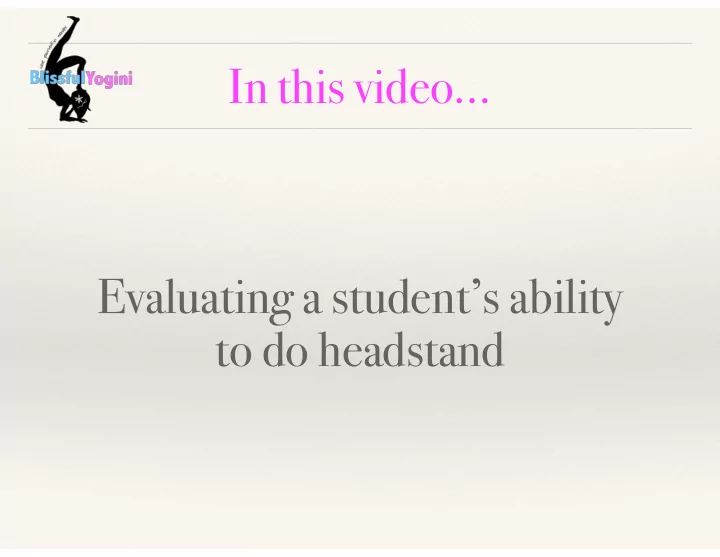

In this video… Evaluating a student’s ability to do headstand
Evaluating students ❖ The “ideal” student for headstand (only a SMALL portion of the class—if any!): ❖ mid-20s to mid-40s ❖ good strength to weight ratio ❖ fair amount of yoga experience ❖ moderately flexible ❖ no fear of inversions
Teacher’s challenges ❖ Keeping all students safe ❖ Helping students to learn the skills they need ❖ Knowing what each student needs ❖ strength ❖ flexibility ❖ confidence ❖ to not do it at all
Starting them out ❖ Start everyone in the basic open-cup position on the crown. ❖ Come into set up position and walk feet in, leaving toes on the ground. ❖ Stay a few breaths. ❖ Come back down and rest. ❖ Ask for feedback.
What are you looking for? ❖ awareness level ❖ student’s strength ❖ flexibility ❖ body proportions ❖ age ❖ body type ❖ personality
Awareness level ❖ Did the student move elbows out immediately upon dropping the head into position? ❖ Did the student place the head either too close or too far away? ❖ Solution: Repeat instructions and have them do it again.
Lack of strength ❖ Was the student unable to stabilize the base? ❖ Was there wobbling in the torso in the upright position? ❖ Solution: Have student repeat exercise of walking feet in and back down. ❖ Do not continue until more core stabilization work has been done.
Lack of flexibility ❖ Were the student’s elbows unable to stay in position? ❖ Was the student unable to get hips straight up over shoulders when walking the feet forward? ❖ Solution: Work with shoulder openers and use blocks to walk feet up into position.
Difficulty with base ❖ Was student struggling to keep elbows on floor? ❖ Was student rolling onto back of head? ❖ Solution: Adjust base by putting forearms and hands on folded blankets. Adjust hands into closed grip.
Age considerations ❖ Older students: ❖ use shorter holds ❖ more preparation of neck muscles ❖ do another pose altogether
Age considerations ❖ Younger students: ❖ don’t let them overdo it ❖ work on building supportive muscle groups ❖ Both age groups: ❖ General conditioning will affect their ability ❖ Move them slower ❖ Start with shorter holds ❖ Give another pose entirely
Body types ❖ Kapha ❖ softer with low muscle mass or untoned muscles ❖ tends to be less stable in core and more wiggly when in full pose ❖ typically needs more core strengthening
Body types ❖ Pitta ❖ athletic and typically stiffer ❖ tend to be tight in hamstrings, low back, shoulders ❖ may need blocks to get hips over shoulders
Body types ❖ Vata ❖ willowly, less muscle mass ❖ tend to be weaker in the joints and sometimes tight ❖ need more general strengtheners and stretches ❖ keep holds short at first
Personality ❖ watch students’ faces ❖ read body language ❖ listen to what they say ❖ give permission to slow down, or not do it at all ❖ allow them to just watch others; sometimes inspiration will prevail
Now what? ❖ Depending on where student is at: ❖ have each student repeat the walking-the- feet-in exercise ❖ then assign each to a different activity ❖ see module 4 for additional exercises
In the next video… Preparing the body for headstand
Recommend
More recommend